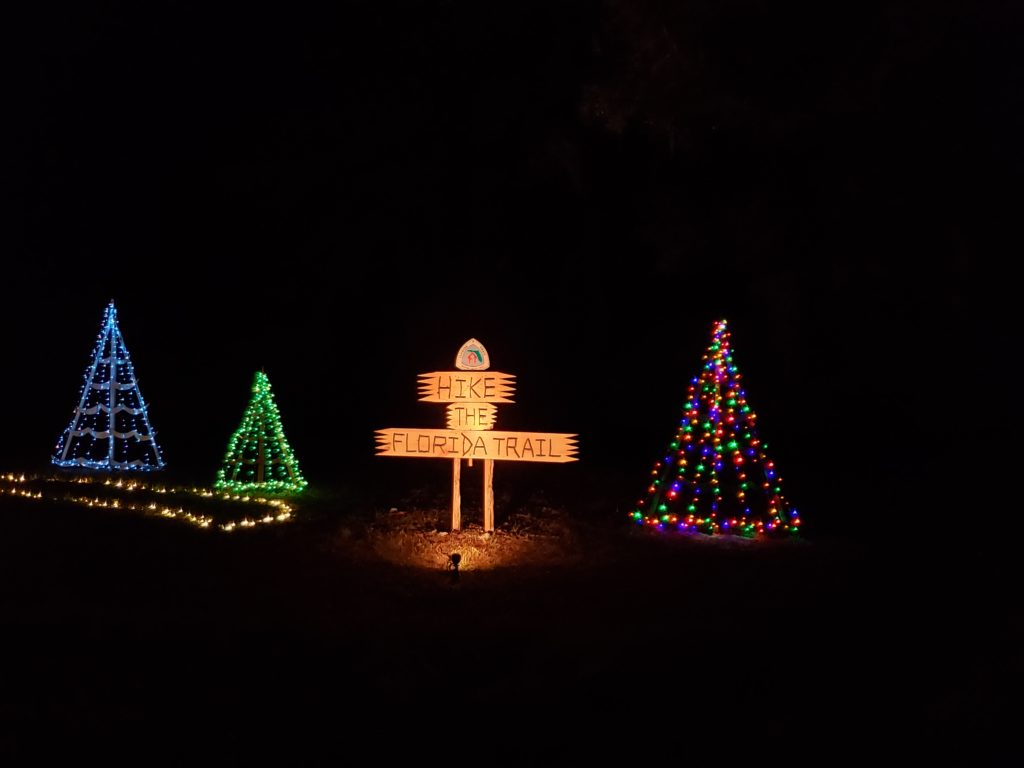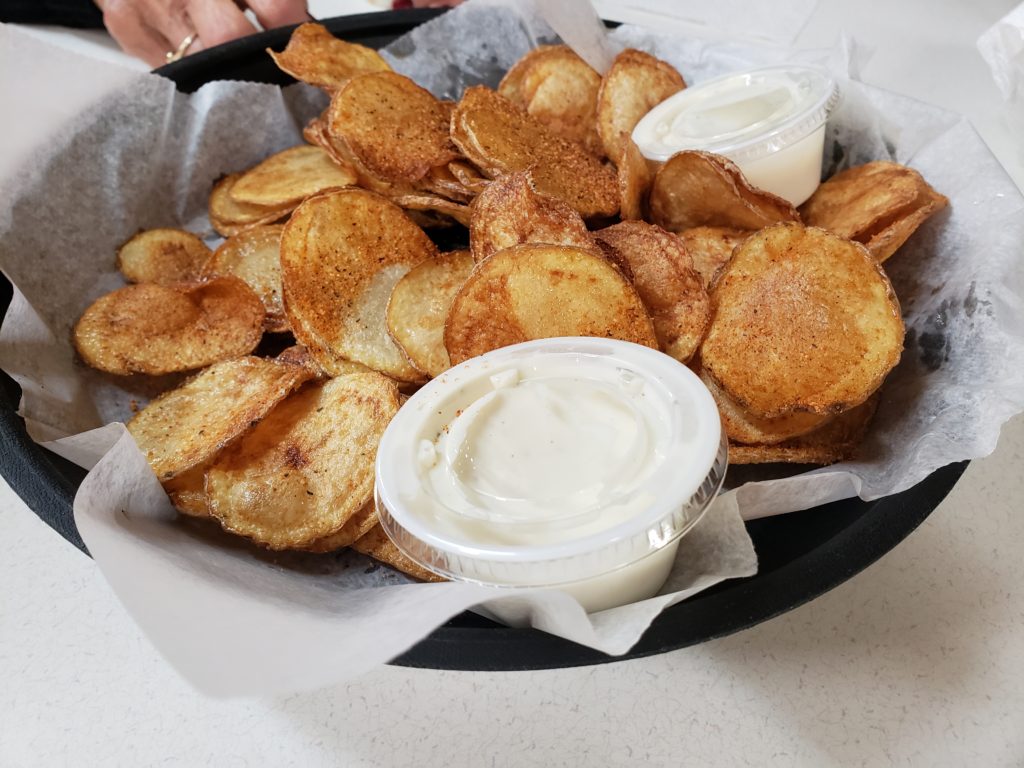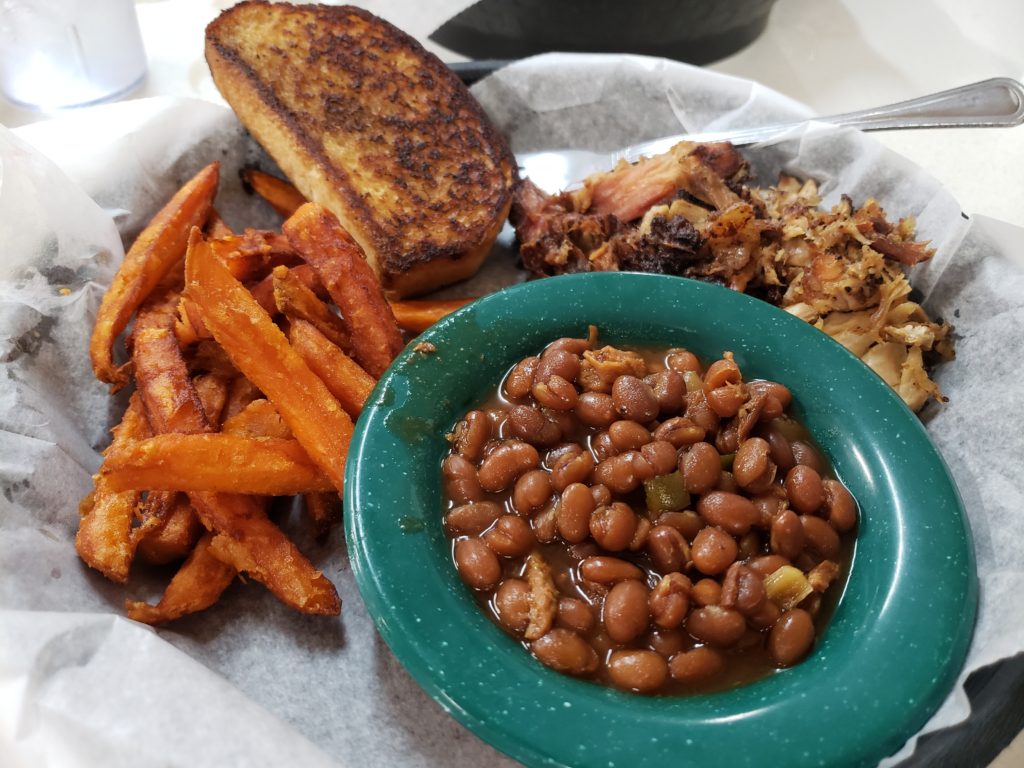Undiscovered Florida – 20 Best Things in Hamilton County
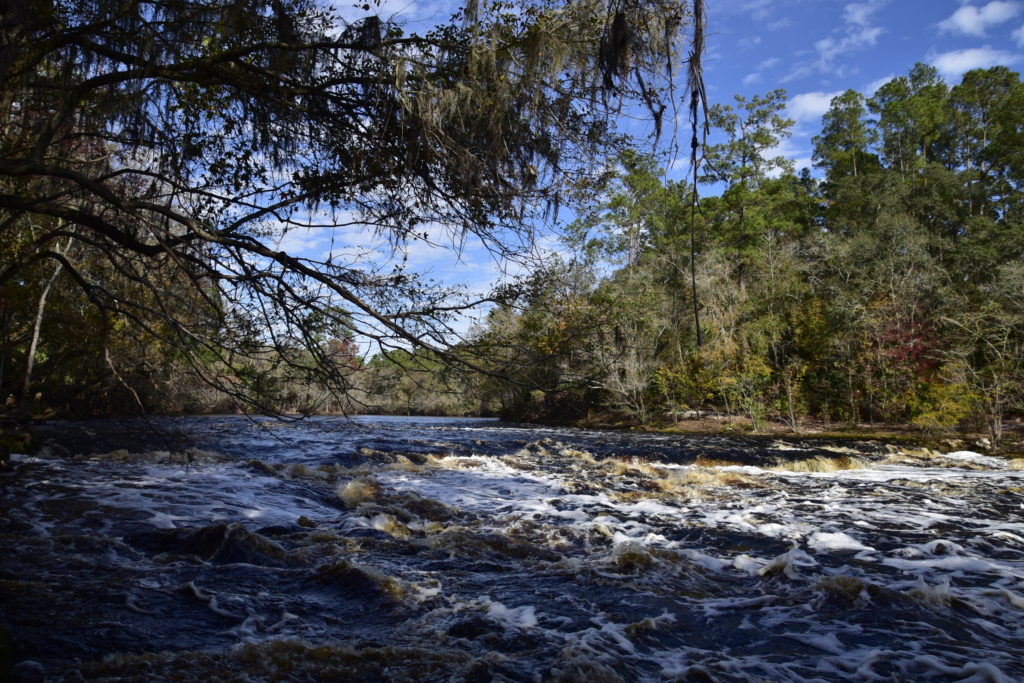
Hamilton County is full of historic places, scenic rivers, and undiscovered trails. Hamilton calls itself “Florida’s Front Porch.” Notice you can hear the quiet. And the beautiful, diverse landscape. You’ll enjoy sitting on the porch.
The county has over 32,000 acres of public lands. Hamilton is encircled by the Suwannee and Withlacoochee Rivers and split in half by the Alapaha. Driving into White Springs from Live Oak, I think I crossed county lines three times in about a mile. Sometimes you are in a county, and when you cross the street (or bridge), you are in another county, even though you’re in the same town! And since frequently the rivers are county lines, as you float down a river, one county will be on your left, and another county on your right!
1. Big Shoals State Park
Big Shoals has been a place of recreation, hunting, fishing, and shelter for at least 7,000 years. This extraordinary place still attracts people with its mineral (sulfur) springs and its rapids for kayaking. There are beautiful vistas of the Suwannee River from the riverside bluffs. The area was used as a quarry by Native Americans, who made stone-chipped tools from the river’s limestone.
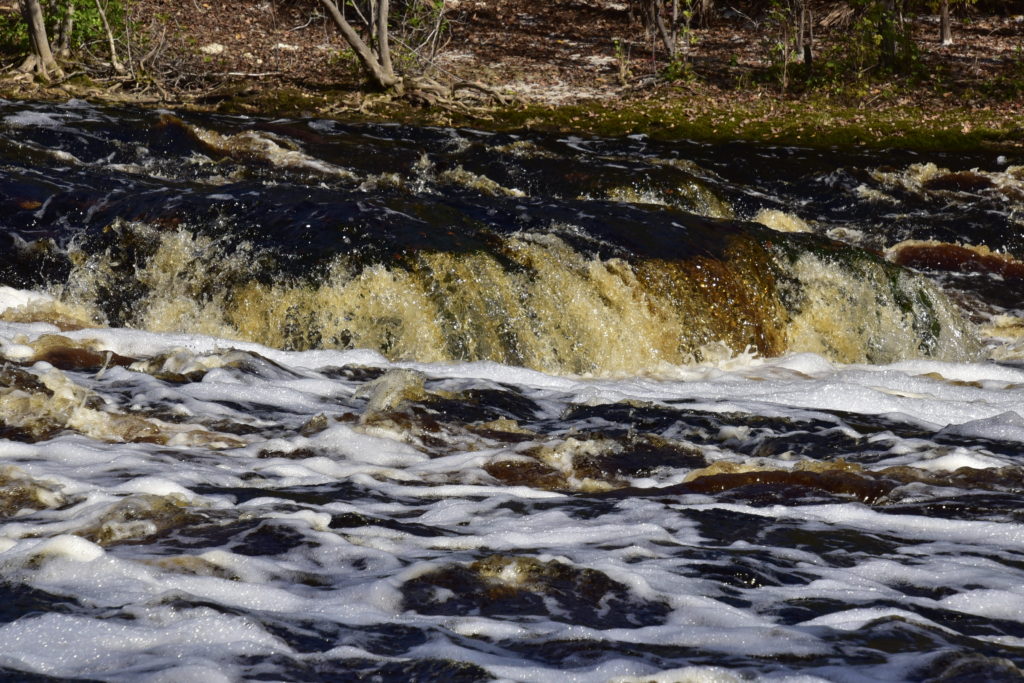
2. The Undiscovered “Other River”
Natural North Florida is known for its rivers: the Santa Fe, Ichetucknee, Withlacoochee, and Suwannee. But what about the Alapaha? It was described as “unspoiled, wild, and scenic” in 1979, and as “jungle-like in its remoteness…the dark reddish-brown waters of the Alapaha wind through a swampy wonderland teeming with wildlife.” You can expect to see kingfishers, turtles, owls, turkeys, herons, pileated woodpeckers, anhingas, hawks, alligators, and fish.
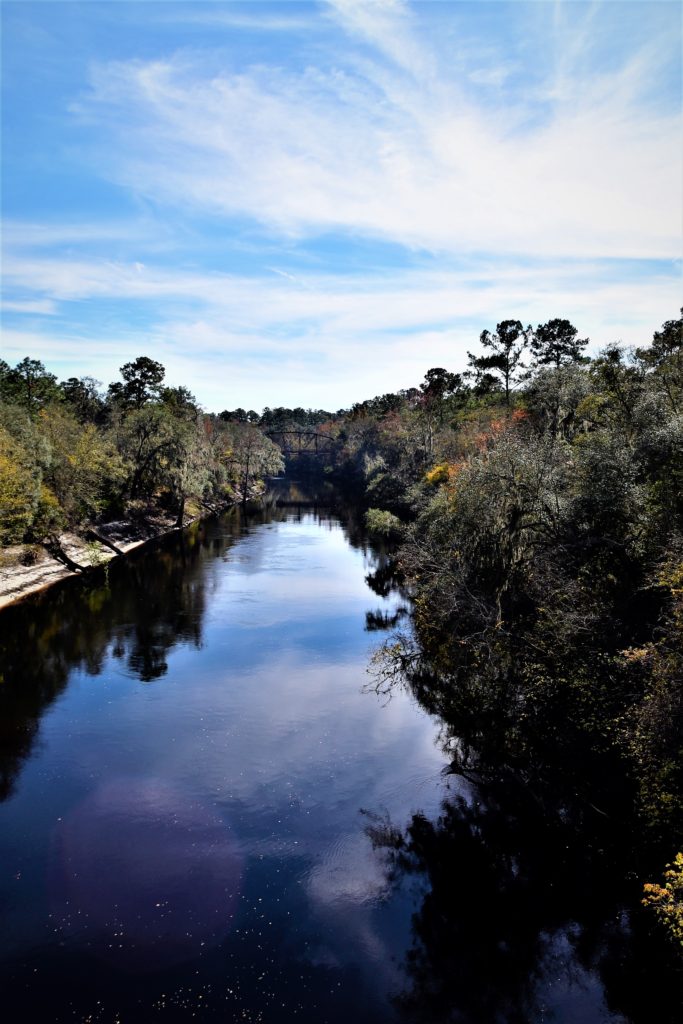
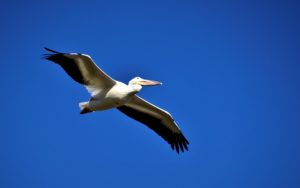
For your own safety, always make a float plan before you head out. There is a free one online. What a handy way to leave emergency information at the put-in and take-out points!
Starting in Georgia, the Alapaha River flows 202 miles, ducking underground at the Dead River Sink and returning above ground in the Alapaha Rise. It joins the Suwannee River in Hamilton County, and they make their way to the Gulf of Mexico. During the dry season, the water is so sparse you can hike the sandy path of the riverbed. There are a couple of places in Hamilton County to access the river and find camping spots: Gibson Park and Jennings Bluff. Jennings Bluff is a part of The Great Florida Birding Trail.
Jennings Bluff is a coming attraction for Hamilton. The plans are drawn for a camp, and step one will be restrooms. The area is beautiful, with tall bluffs. My host, Mia Mauldin, was a fearless leader, so off we went to the bottom to explore the stream and cypress knees.
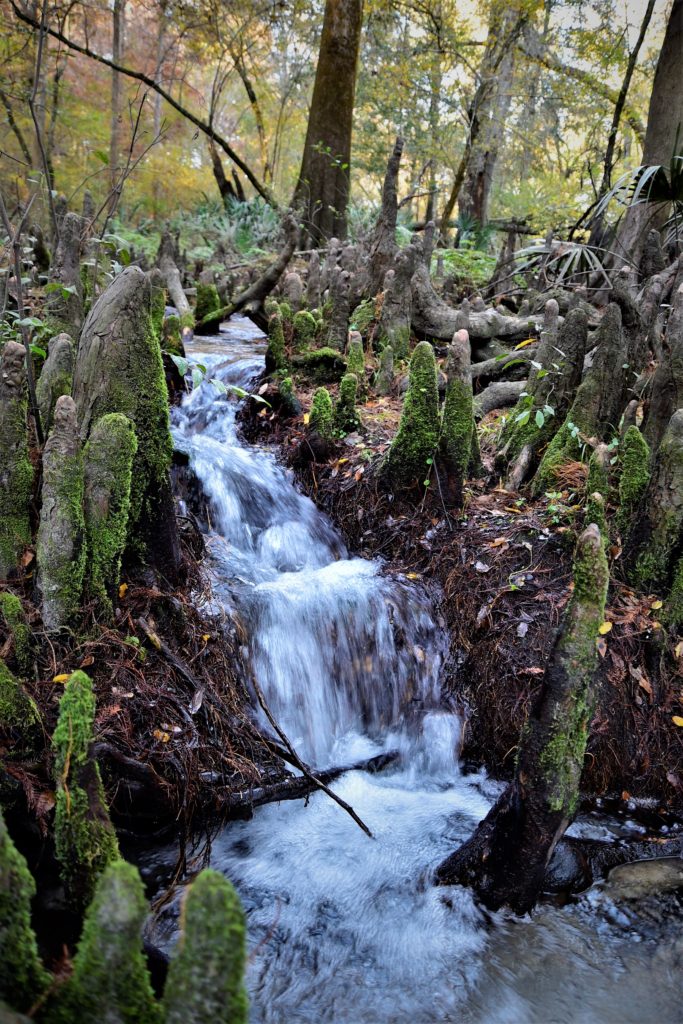
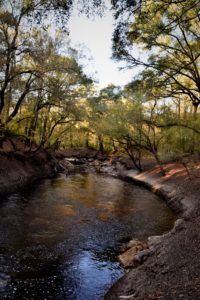
An undiscovered secret at Jennings Bluff is the Dead River or the “disappearing Alapaha River.” The river flows into a large pool, and the next thing you know, it has been “sucked” down a big hole and disappeared under the bluff. The mystery – where did it go!?
3. That Smell is Sulphur!
The sulphur springs in White Springs, thought to have curing powers, were used by the Native Americans until the early 1800s, when the European settlers moved into the area. The spring is a second magnitude spring, and the natives believed the place to be sacred, so the healing spring was visited by the sick from all tribes, and they were not disturbed while at the spring.
By the 1830s, White Springs was being promoted as a health resort. The first mineral spring to be commercialized was called Jackson Springs. In 1831 a log spring house was built. By the 1880s, there were 500 rooms for rent in area hotels and boarding houses.
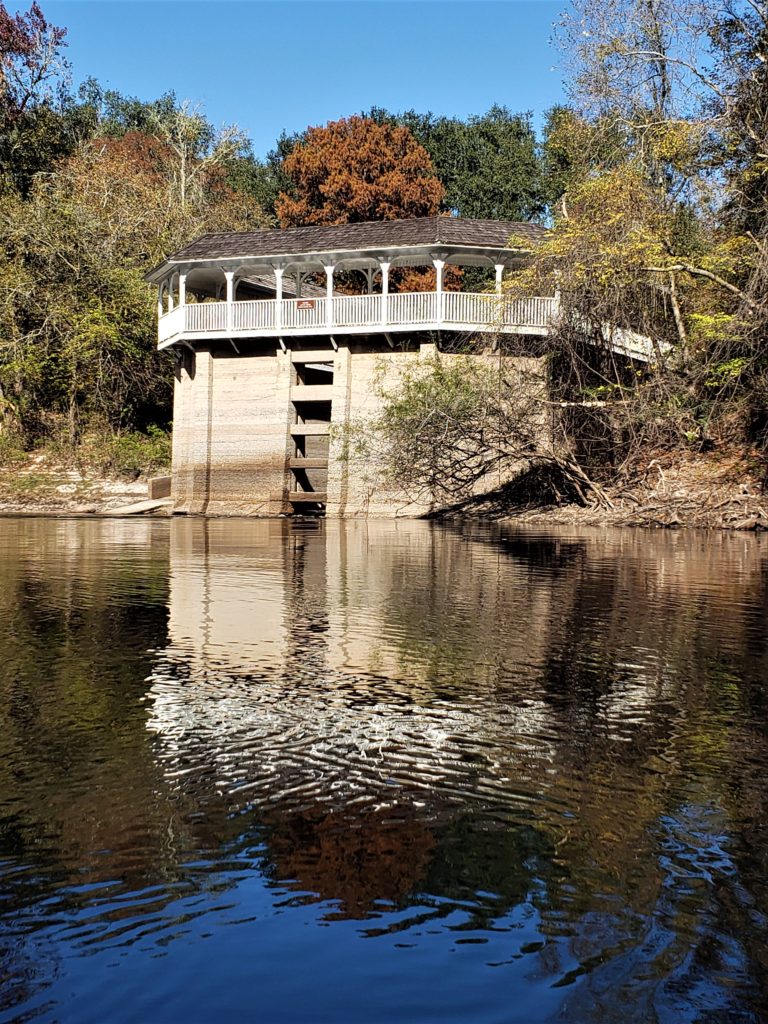
The concrete and coquina structure that stands today was constructed in 1903. Clinical exam rooms, dressing rooms, and shops were built next to the spring. Four levels of balconies surrounded the spring. The area thrived on tourism while “tourism” was still an undiscovered source of revenue!
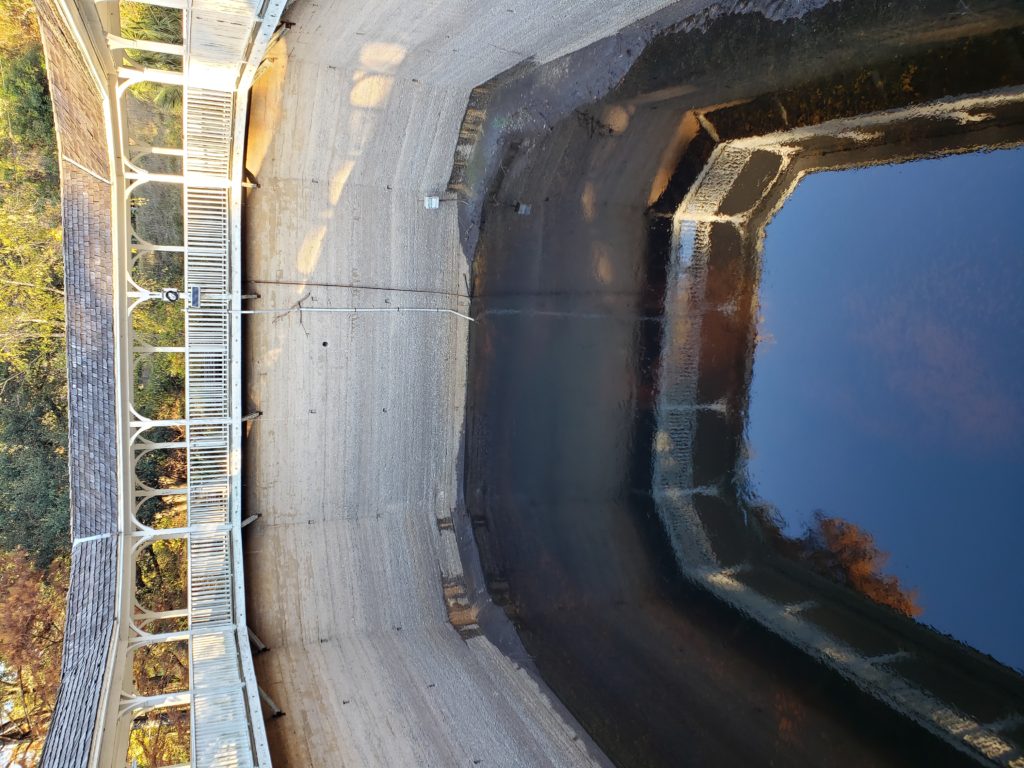
During the Civil War, families who evacuated Florida’s coastline came to the area for safe shelter in the undiscovered “Rebels Refuge” along the river.
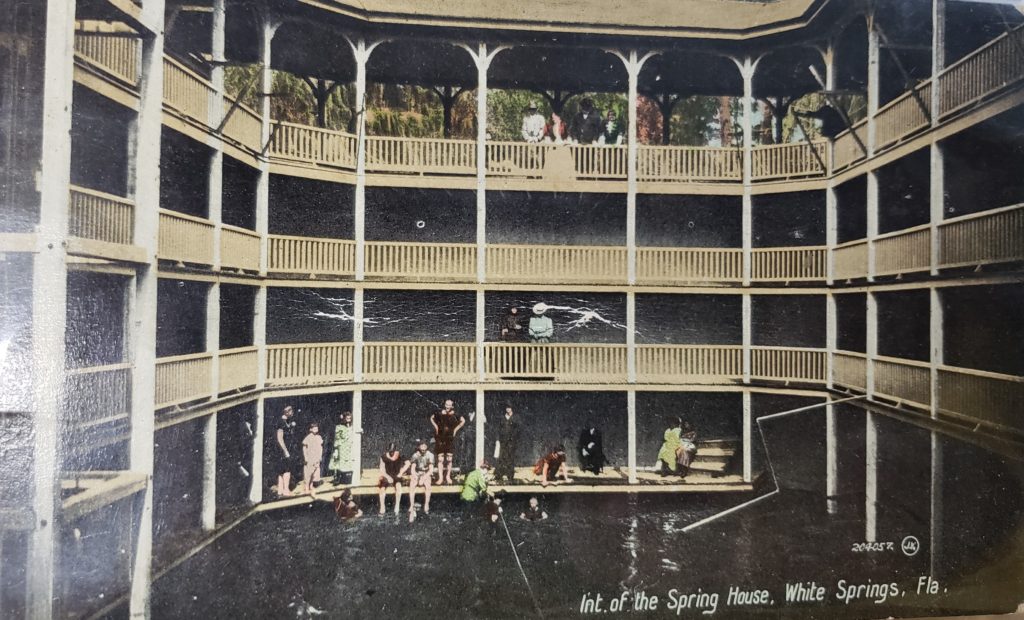
4. Float on Down the River
The Suwannee River usually flows at a rate of two or three miles an hour. It provides a leisurely trip, and there are white sand beaches along the way—just begging for picnic stops. But pick up a map, and ask a few questions before starting out. The upcoming Big Shoals is a section that requires portage. So you need to know where to stop paddling and start toting your boat if your put-in is above the shoals!
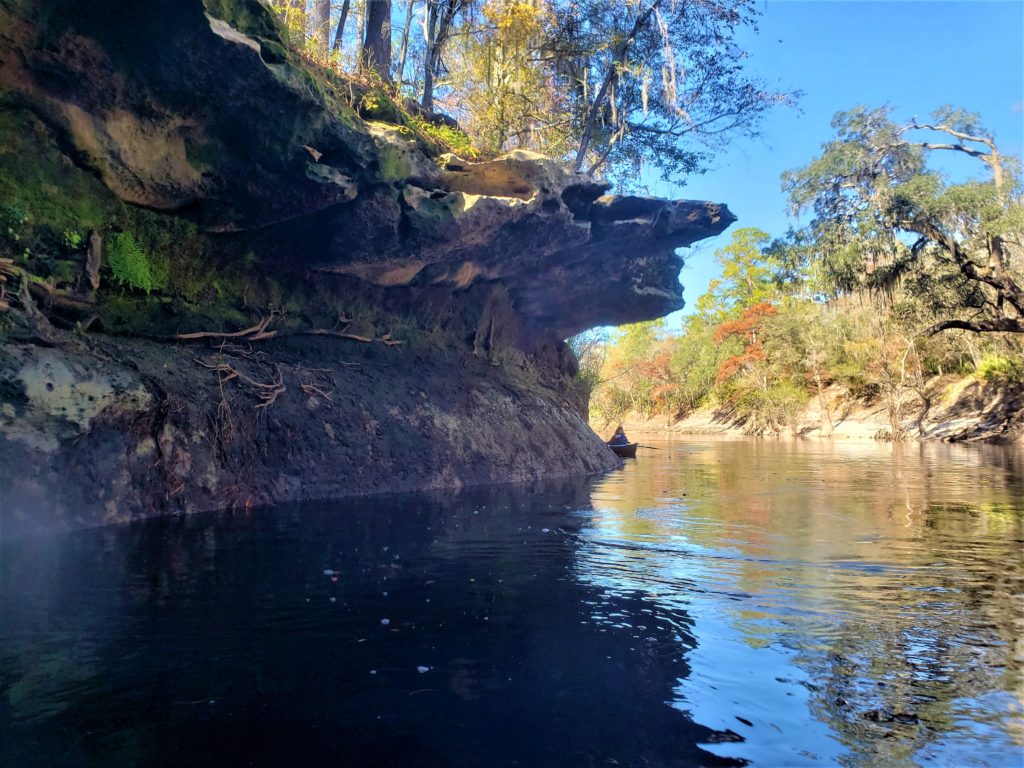
The steep ravines and high bluffs surrounding the Suwannee and those elevations permit the river to rise to 65 to 135 feet above sea level. When the water reaches 59-61 feet, Big Shoals turns into a Class III White Water area! Those elevations also provide growing areas for species more typically found in the Appalachians. Talk about undiscovered diversity!
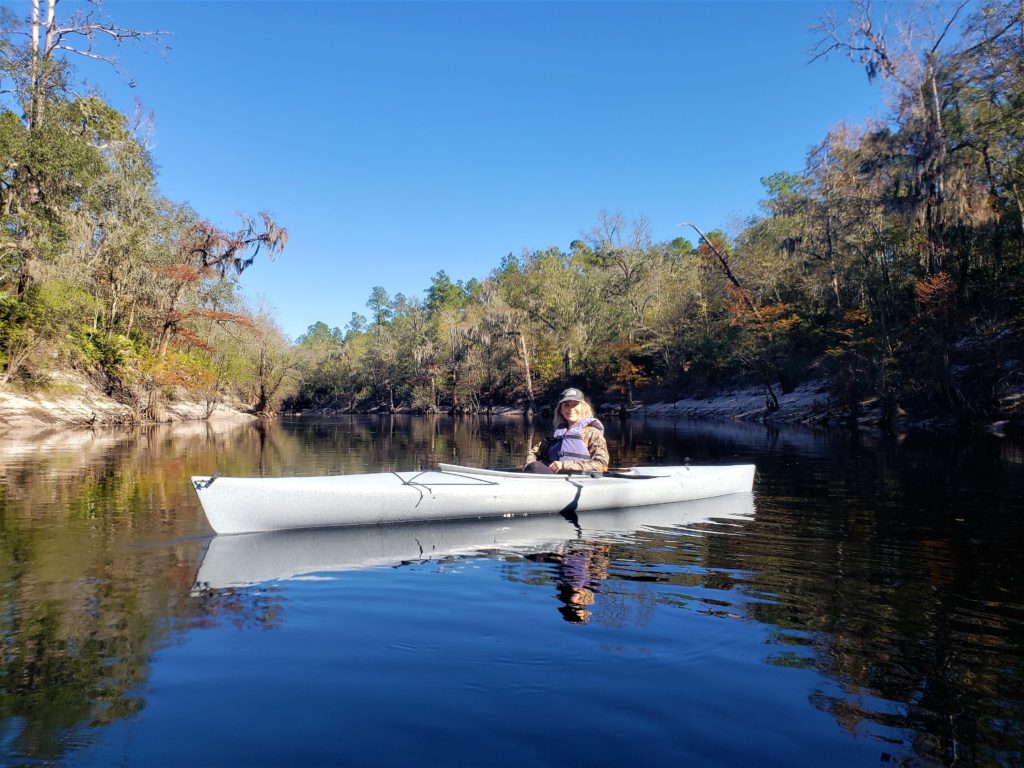
The Hannums, over at American Canoe Adventures, can help you plan and take a trip through undiscovered water adventures. The boatshed is right on the corner in White Springs. Whether you need a kayak for a few hours, a complete vacation package, or to finally buy your own Old Town Canoe, ACA has you covered. This family-owned place has been serving the people visiting Hamilton County since 1995. They provide shuttle services to popular Suwannee River locations from the Okefenokee Swamp to the town of Suwannee on the Gulf of Mexico. I think the guys must love to drive!
Interesting tidbit: There are five bridges with Suwannee River in their name.
5. Enjoy the Music
The 200-foot Carillon Tower at Stephen Foster Folk Culture Center State Park houses 97 bells that play concerts daily. The carillon is one of the largest musical instruments made in the Western Hemisphere. It is also the world’s largest carillon (in number of tubular bells), they were installed in 1958.
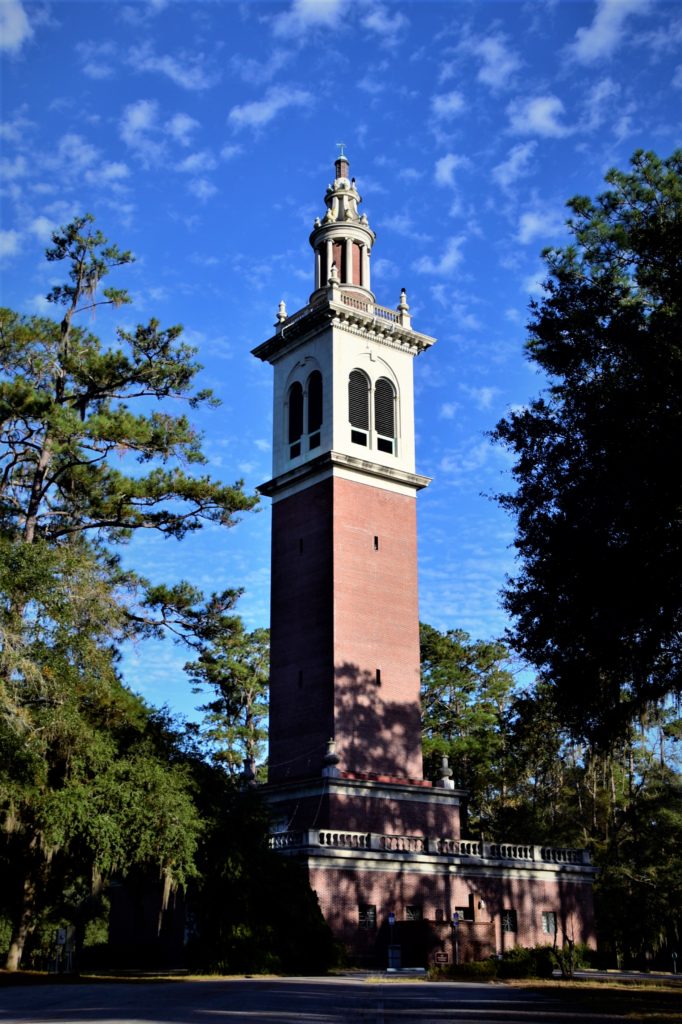
The carillon holds an electronic roller that plays Foster’s tunes, which echo across the park’s grounds. On the first floor, visitors find historical exhibits and dioramas that depict the scenes described in Foster’s songs.
6. Roadtrip!
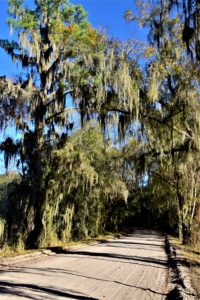
Take a tour of the back roads in your car. You can spot wildlife right along the road if you just know what to do and where to look! Animals and birds have become accustomed to vehicle traffic, so you can “sneak up on them” in your car. Get out early in the morning or late in the afternoon—those are the primary times that animals are moving. The east side of Hamilton County is more wooded, so you can expect to spot wildlife: turkey, deer, owls, bald eagles, hawks (watch the utility lines above your head!), the occasional bear, armadillos, and hogs. Drive slowly and stick to the dirt roads. After a rain, roadside ditches will be filled with water, attracting birds.
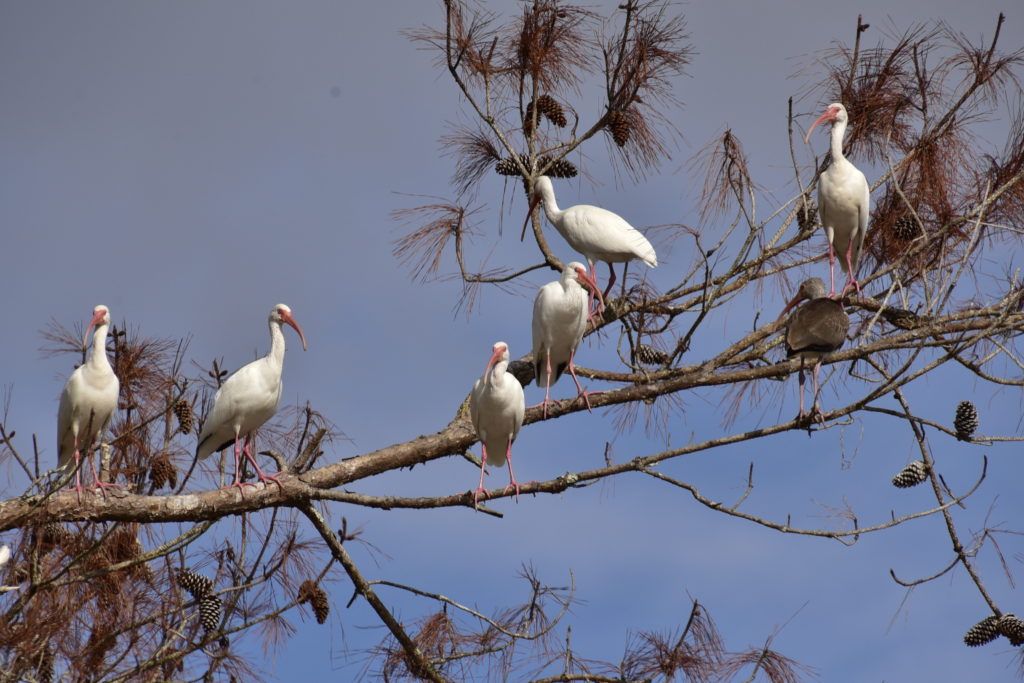
While paddling, do it quietly. Don’t yell back and forth to your fellow paddlers, and keep the music off. You’re on the river for a peaceful time, so make the most of it. This way, those undiscovered birds and otters will be discovered.
7. Spend the Night with Stephen Foster
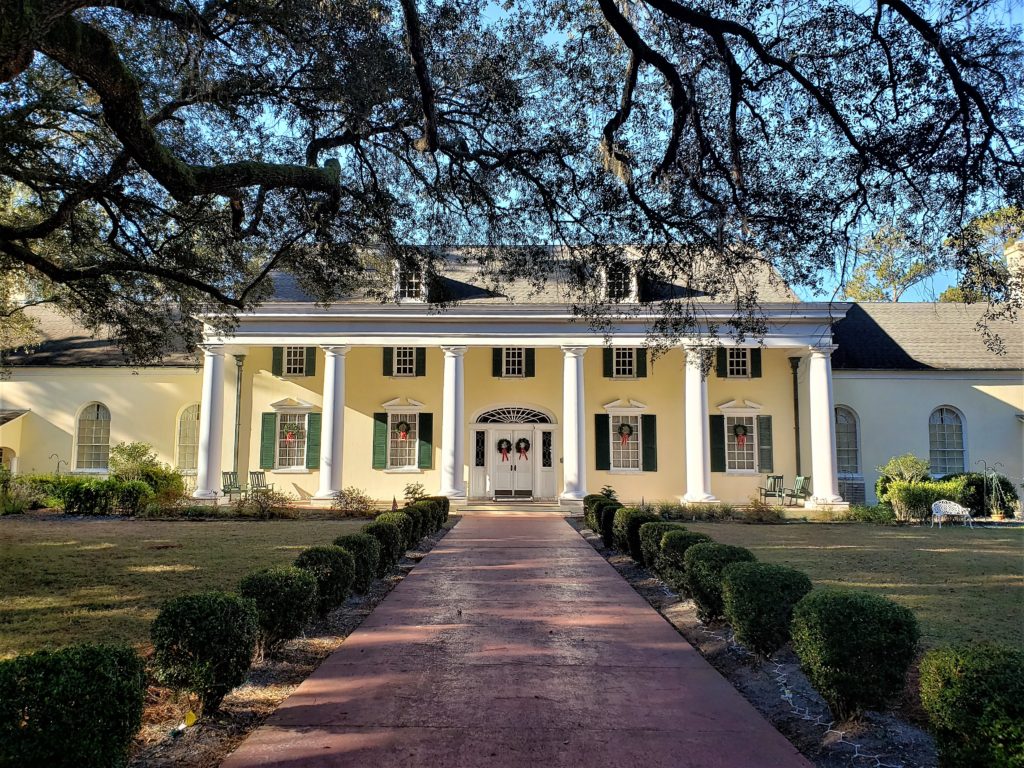
In 1931, Josiah Lilly, son of Eli Lilly (the pharmaceutical manufacturer,) came up with the idea of a memorial to Stephen Foster, the composer of over 200 songs in his brief life. The Florida Federation of Music Clubs took the plan and ran with it. When they received a donation of land in White Springs, The Center was born, and the park opened in 1950. In May of 1953, the first Florida Folk Festival was held, and this will be its 70th year!
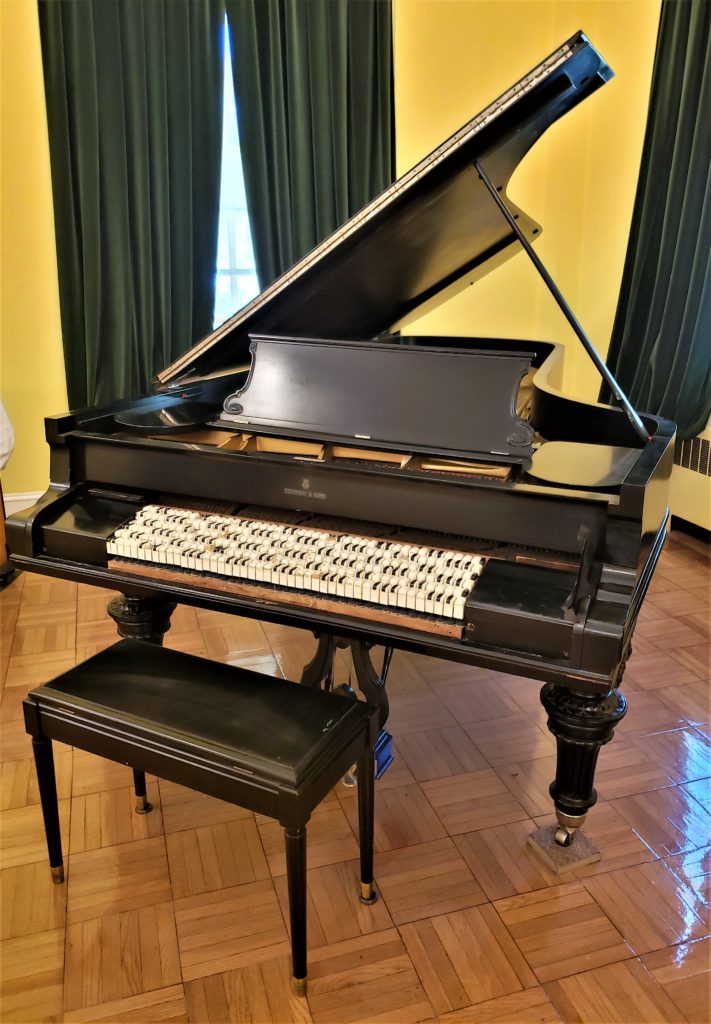
The museum has an embarrassment of musical riches—it did start out operated by music clubs, after all! I’m no expert, but I found the beautiful pianos, keyboards, and organs a fantastic display. There is one I’d never heard of or seen (no surprise there!) called the Paul von Janko Keyboard. Invented in 1882 in Hungary, it has six rows of keys, arranged in stair-step fashion. You’d think the piano player would need to be built like Vasudhārā, the Buddhist goddess with all those arms! But, as you play on row one, the same keys in the other two “odd” rows engage; and as you play on row two, the corresponding keys on the “even” rows also strike. Concert pianists used the piano before World War I in the United States and Europe. A piano class dropout, I’m lucky to still read music and can find middle “C.”
Now a state park, the center encompasses 888 acres. There are five cabins along the river, near the canoe launch. There is a pavilion for lectures, performances, or just enjoying the shade beside the river. The park also has 45 camping sites for RV or tent camping.
8. Down the River to the Spring House
The Suwannee was flowing slowly during my visit. It made for an ideal morning floating lazily downstream in my canoe. The water was as smooth and provided perfect reflections for photography. Canoeing put me right across the river from White Sulphur Spring and the remnants of the bathhouse.
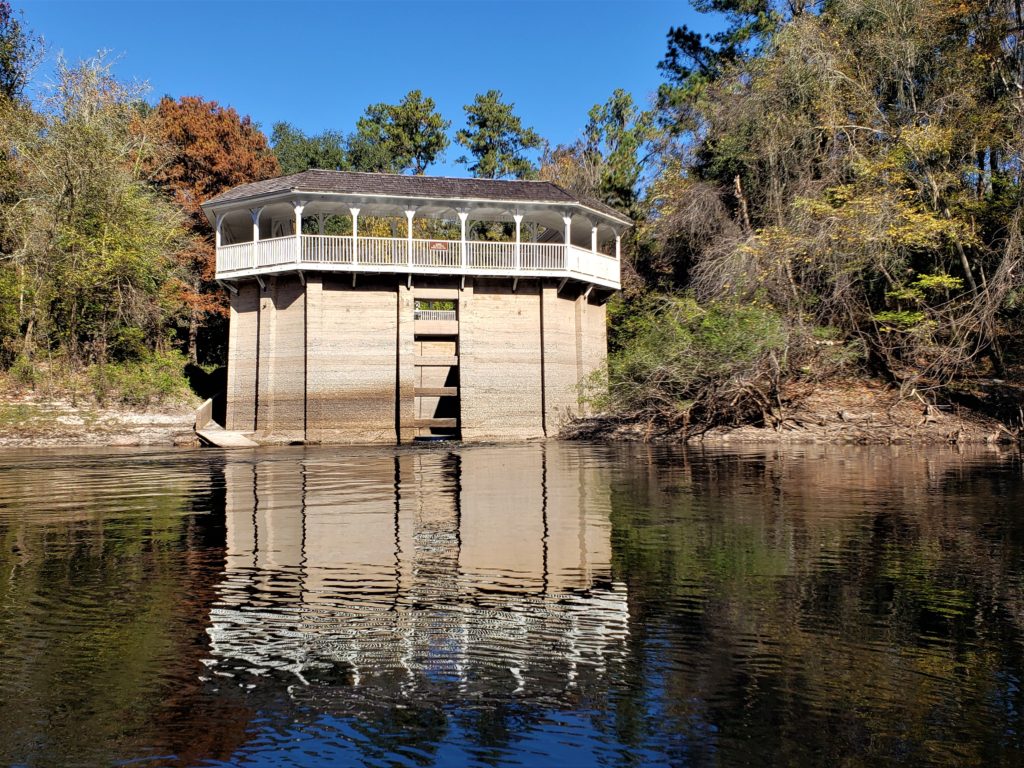
The 3-mile trip took a couple of hours, but I stopped for photography (a lot!). My host, Mia, and I started at the US 41 Bridge and kayaked to the Stephen Foster State Park, right in my cabin’s backyard!
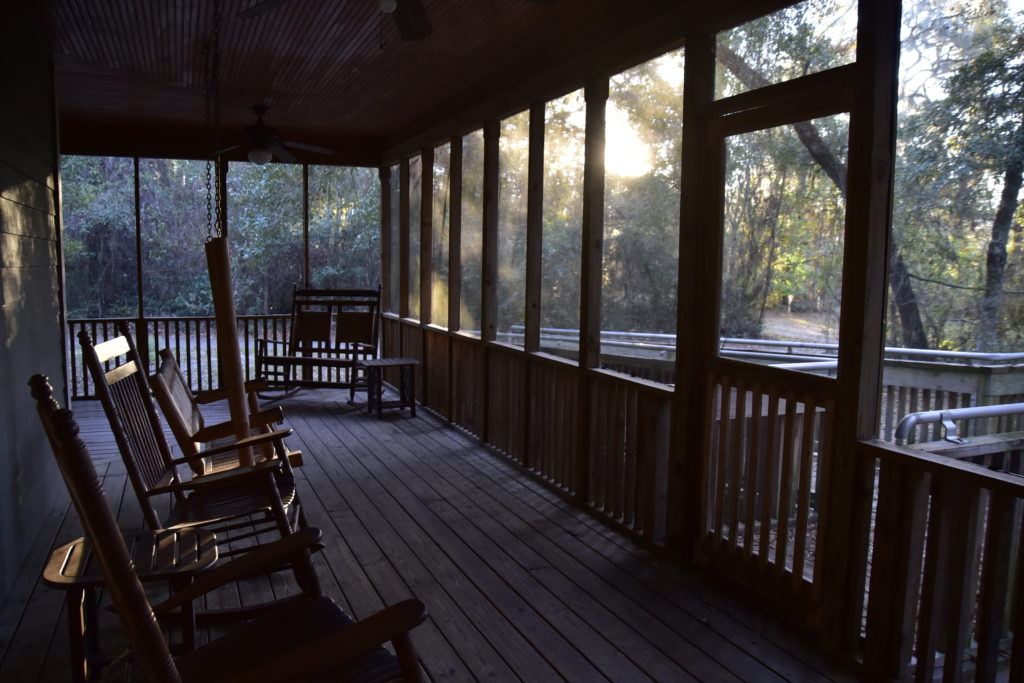
9. Bird Watching
I saw a sign for an entrance for farmers. I thought I’d found a local farmer’s market, which I love, but it turned out to be more of a shipping center with lots of 18-wheelers. BUT…making that wrong turn meant I had to find a way back out of the parking area…and the search took me along the side of a small pond. Now, photographers are constantly scanning for subjects, and sure enough, I spotted a big bird near the water’s edge. Zooming in, I was thrilled to realize I had spotted a young Bald Eagle. You know they’re a juvenile when their head hasn’t turned white yet; that usually happens between the fifth and seventh year.
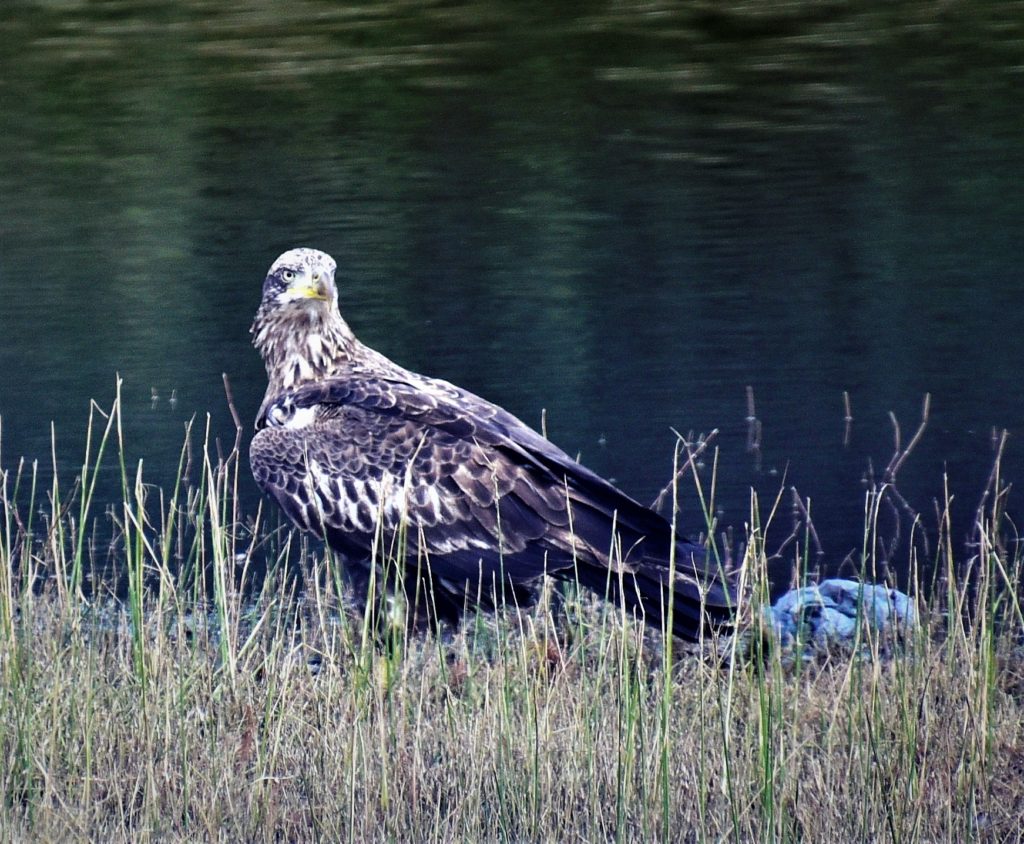
10. Fat Belly
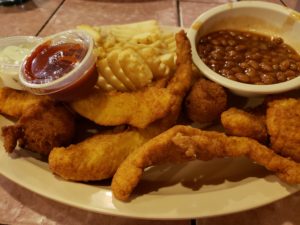
No! Not mine (well, I’m not admitting it anyway.) I’m referring to Fat Belly’s Bar B Que & Grill in White Springs. That’s an important statement—White Springs is small. Having a good restaurant in town is a real bonus. And Fat Belly’s is good—really good. If I lived there, I might have to own up to that description! My catfish fingers (no bones!) were light and perfectly fried. It came with yummy waffle fries, hush puppies, and baked beans. And sweet tea. Lots of tea. Hiking makes you hungry and thirsty! My host Mia had fried shrimp and doubled up on the waffle fries (she admits to being hooked!), and Park Ranger Watkins ordered the fried chicken and sweet potato fries. Everything looked good, smelled better, and tasted marvelous! Everyone in the place knew each other, and it didn’t take them long to meet me. You gotta love a small town.
11. Scavenger Hunters
Geocaching is described as high-tech scavenger hunting. Done with a hand-held GPS, it sounds like fun to me! I hear there are many sites in the White Springs area, so I just may have to learn more about this hunt for undiscovered treasures!
12. Dioramas
Inside Stephen Foster State Park, the museum with those gorgeous pianos also has a display of dioramas, and there are several others on display on the Carillon tower’s ground floor.
The dioramas illustrate some of Foster’s most popular and regional songs, like Way Down Upon the Swanee River, also known as “Old Folks at Home,” Camptown Races, Jeanie With the Light Brown Hair (written about his wife), and My Old Kentucky Home. Interesting Tidbit: There are two states whose songs were written by Foster. Can you name them?
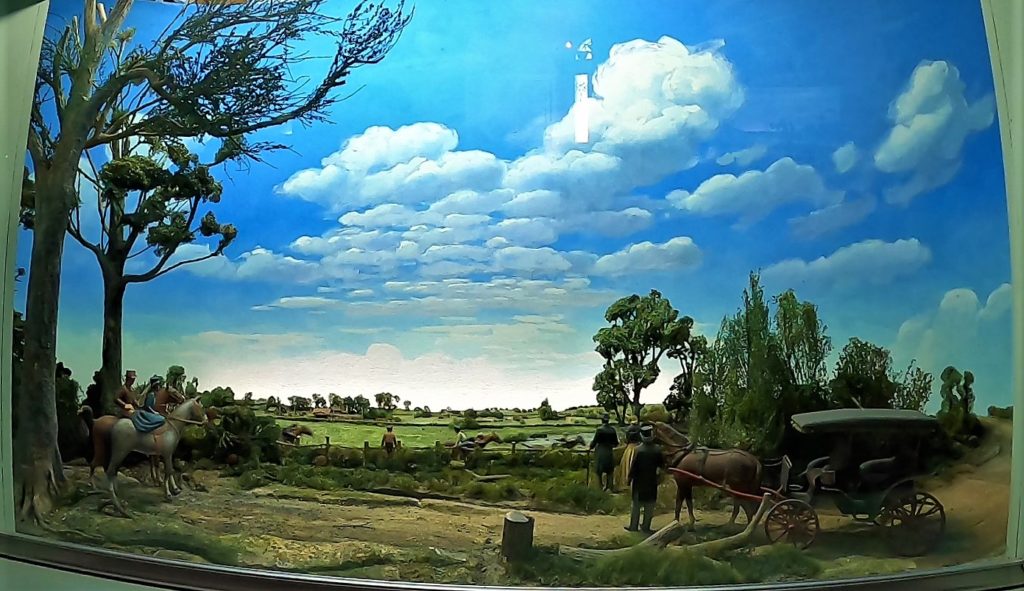
Dioramas are much more involved than they appear. At first look, they seem just to be a big 3-dimensional painting. That is until you start examining all the moving parts! A behind-the-scenes look revealed lots of gears and pullies, and parts of the diorama hanging upside-down as it rotated out of sight before reappearing at the beginning again. Fourteen artists spent almost two years creating the first eight in the display. Each diorama has about 1,500 hours of work invested. And the minute attention to detail—my goodness!! For instance, in Camptown Races, the track would have been at least an eighth of a mile across; but in the diorama, the distance allotted was a mere 16 inches to give the appearance of a horse race.
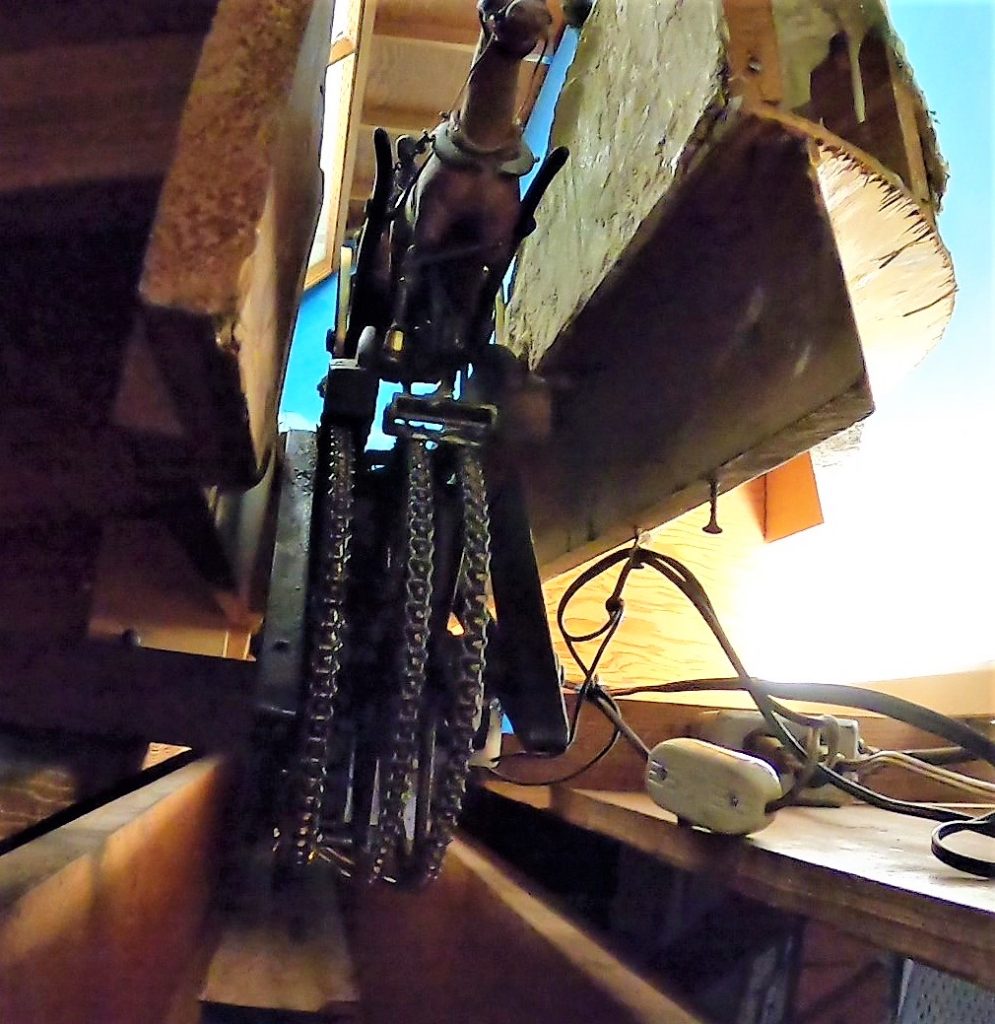
13. Dining Out at Jennings Crossroads
Start off your meal at T & T BBQ with a basket of hot fried potato chips. And ask for some Bleu Cheese Dressing to dip them in. Trust me. Then have a heaping helping of pulled pork barbeque. They smoke it out back. And, of course, you have to have baked beans, sweet potato fries, and Texas toast.
14. Step Back in Time
Take a walking tour of White Springs and enjoy the feeling of a simpler time. The Historic Walking Tour brochure lists 25 buildings in just a few town blocks. In 1997 the historic district recorded 110 structures on the National Register of Historic Places. This is even more remarkable when you learn about the February 1911 fire. That fire started in the Baptist parsonage and quickly spread through the town’s business district, destroying 35 structures!
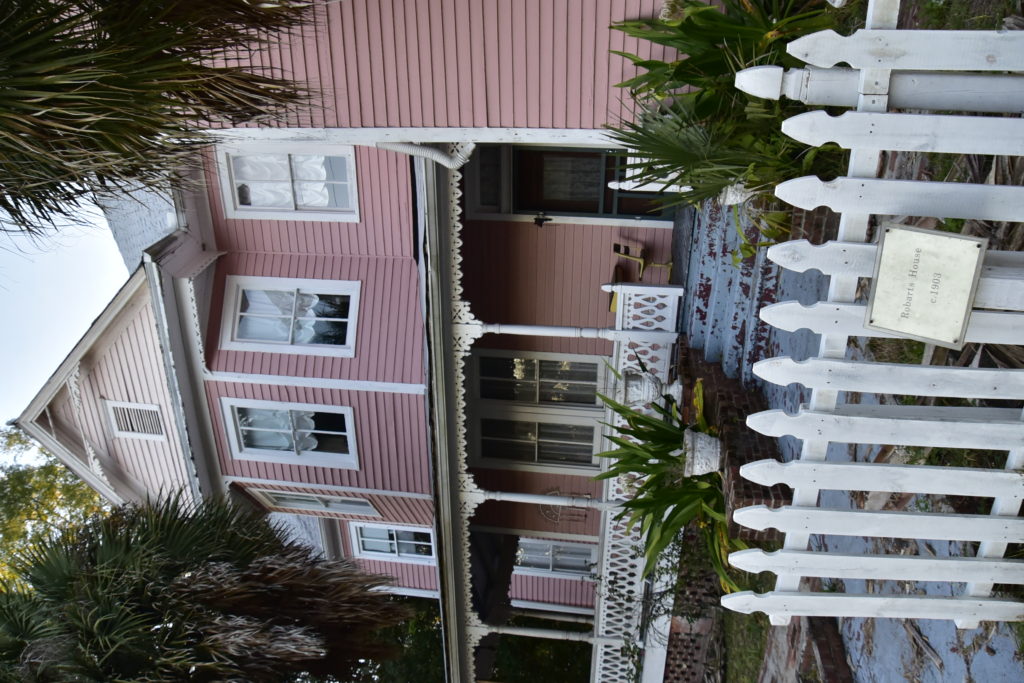
1903 Robarts House 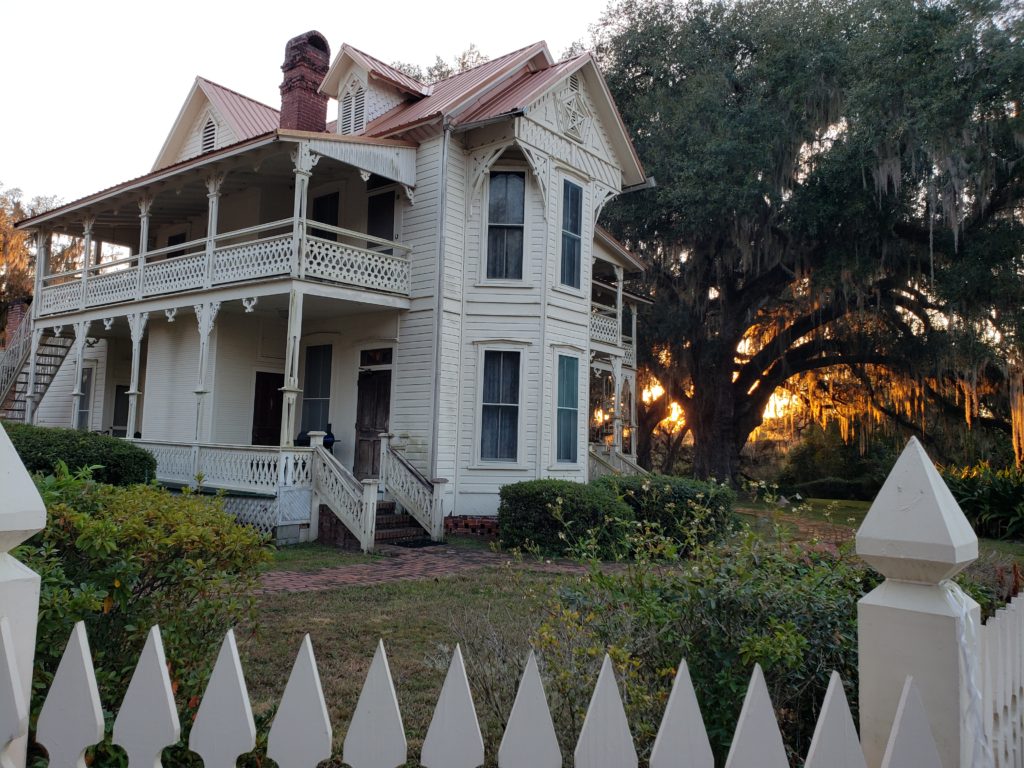
1893 Sophia Jane Adams House
The stately home above the Suwannee River was built in 1893 by the widow of Robert Adams, of the Adams Brothers Store. Just up the street is the 40-room river rock and brick hotel known as the Telford Hotel, built in 1903. Not too long ago, it was a restaurant. I’m ready to eat there and go upstairs for the night. Somebody–please buy this fabulous landmark! I’m positive there are more undiscovered secrets here!
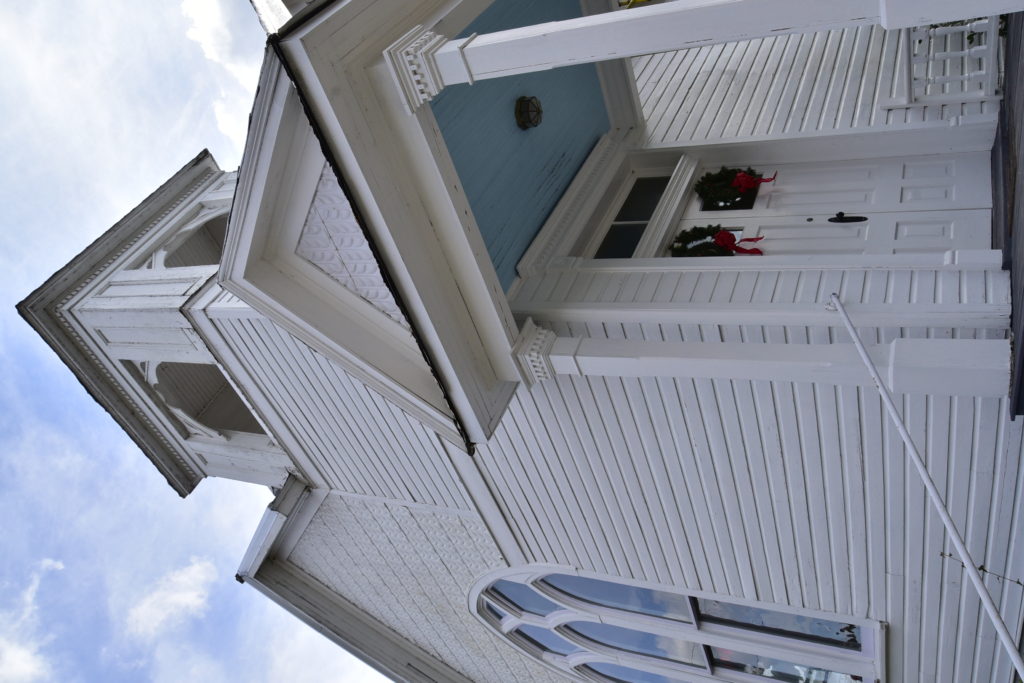
1907 Presbyterian Church 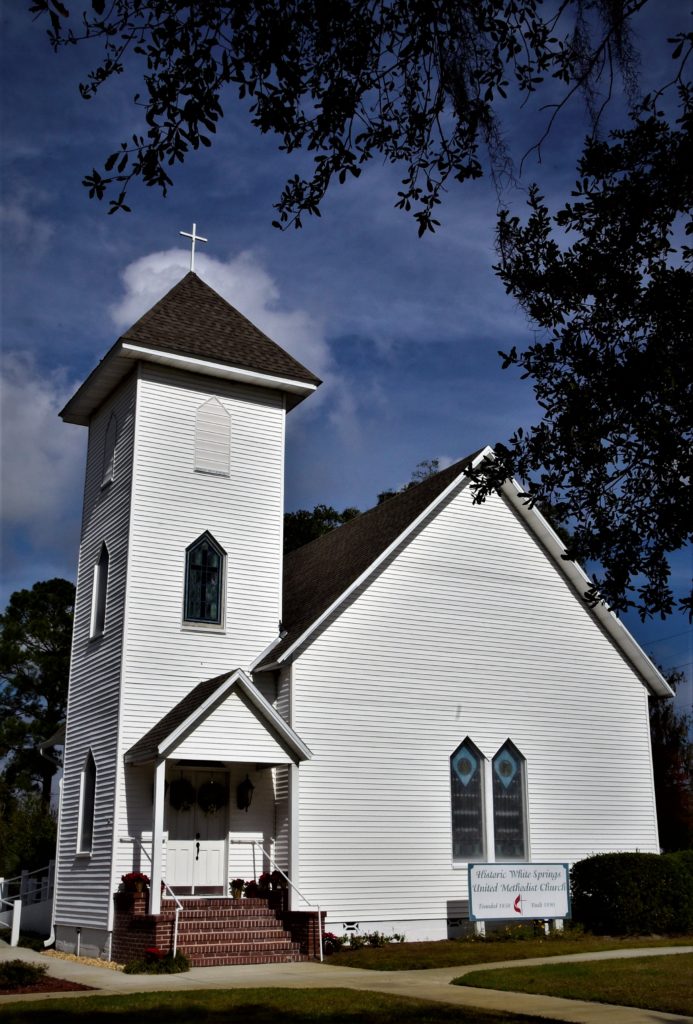
1890 United Methodist Church
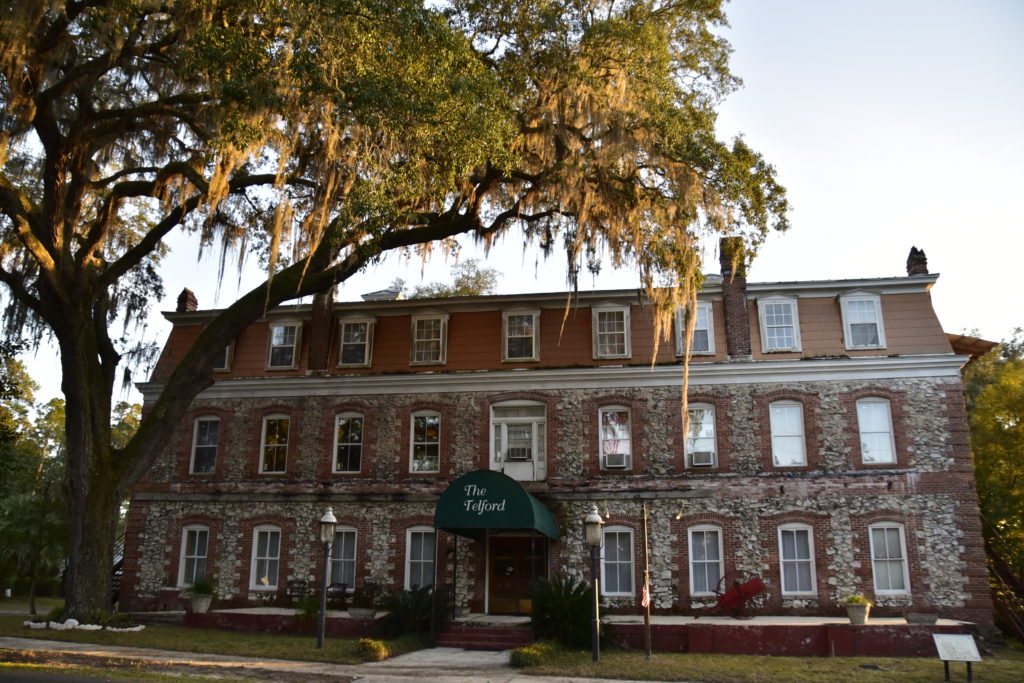
15. Undiscovered Hiking Trails & Bike Paths
At Big Shoals Public Lands, the Godwin Bridge Road and Little Shoals are connected by the paved 3.4-mile Woodpecker Trail for hiking and cycling. There are miles of multi- and single-use trails in the park and along the Suwannee providing for horseback riding, off-road biking, and hiking. Trails traversing the public lands range from .5 miles to 6 miles, one way.
Visitors to Stephen Foster State Park can explore the ten-mile Hammock Loop Trail on foot or by bicycle or horseback. The Florida National Scenic Trail follows the Suwannee River right through the park. The four-mile Carter Camp Trail in the park passes through limestone formations.
Twin Rivers State Forest is at the Withlacoochee and Suwannee Rivers junction. Historically, that spot was an important point of commerce. Both rivers were traveled by steamboats bringing goods and people to the area. Today, miles of trails allow for nature study, hiking, biking, horseback riding, canoeing, kayaking, and fishing in the western part of Hamilton County.
The Suwannee River Wilderness Trail begins at the Stephen Foster Folk Culture Center State Park and runs 170 miles to the Gulf of Mexico. The “trail” is a system of stops and river camps (accessible only from the river) that are spaced one day apart> This allows adventurers to spend a day, or multiple days, in undiscovered areas of the Suwannee River. The camps have screened sleeping platforms, restrooms and showers, and electricity with ceiling fans! There is a telephone reservation system (800-868-9914.) You can see so many amazing things when you get off the beaten path! Try it…you’ll like it!
The Suwannee Bicycle Association is headquartered in White Springs. They publish trail maps with QR codes and have ten mapped routes on low-traffic roads. The SBA sponsors near-monthly events to undiscovered places. Maybe you should become a member!
16. Shop for Screwdrivers, Candy, or Antiques
Walk through the hardware store. The Adams Brothers Store was started in 1866 when Robert Adams returned to his hometown after the war ended. This building was completed in 1892. The building is one of Florida’s oldest wood-framed mercantile stores still standing—and in its original location. Interesting Tidbit: In 1999, the storefront appeared in Alan Jackson’s video Little Man. Watch at the three-minute mark.
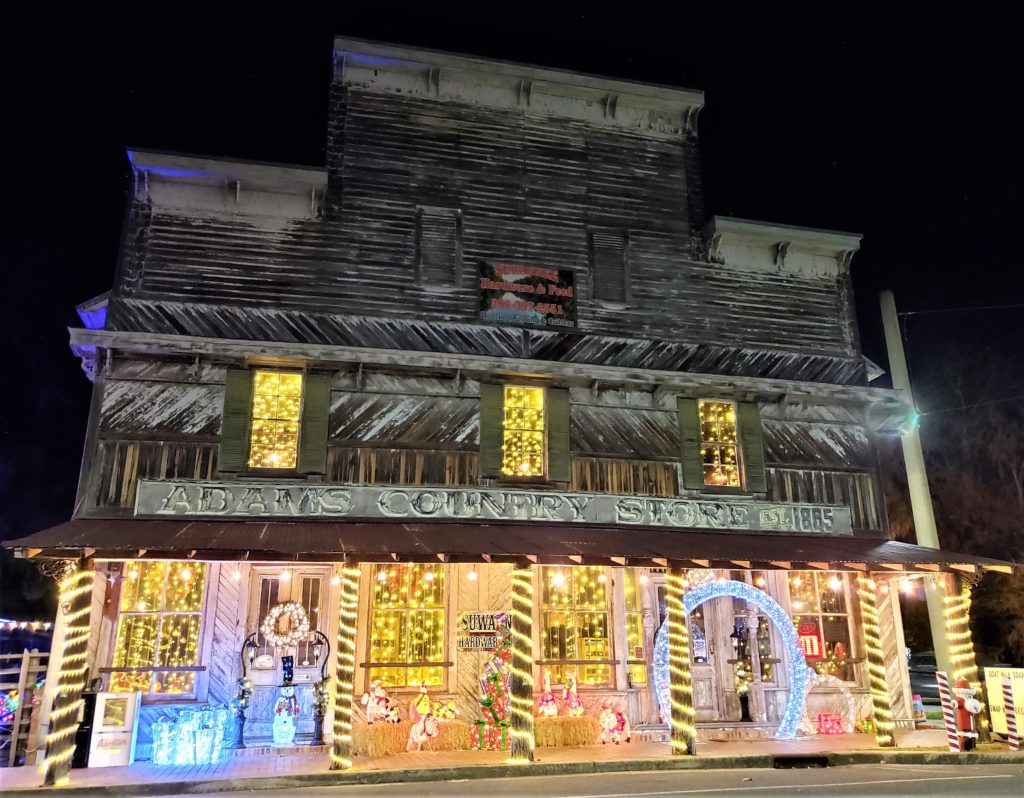
Today, known as Suwannee Hardware, the store is owned by Don and Ann Wilson. They will proudly point out interesting things in the store, like the first commercial refrigerator in Florida and their collection of old postcards from White Springs—a history lesson in a scrapbook! There is a safe in the store, and with some fake TNT you can take an insta-worth selfie!
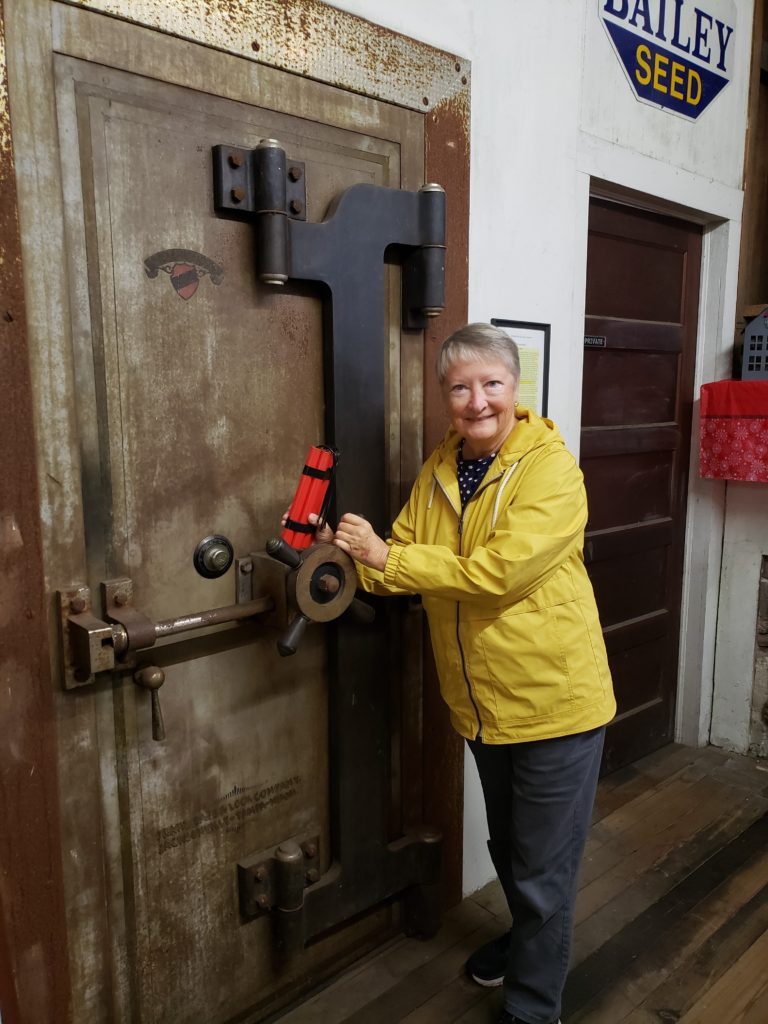
17. Enjoy A Day of Fishing
Fishing in the Suwannee can net you quite a variety of dinner options. The river has a remarkable five types of bass, seven types of catfish, black crappie, sunfish, and numerous bream species. Check in at Rooster’s Outfitters for fishing information or local guide’s contacts. Suwannee Hardware sells licenses for fishing or hunting.
18. Visit Jasper
Make a quick trip up the road to Jasper on a Tuesday or Thursday. Those are the two days that the Hamilton County Historical Museum and Heritage Center is open. It is worth the drive just for the military room, with displays taking you back to the Revolutionary period of our country’s history.
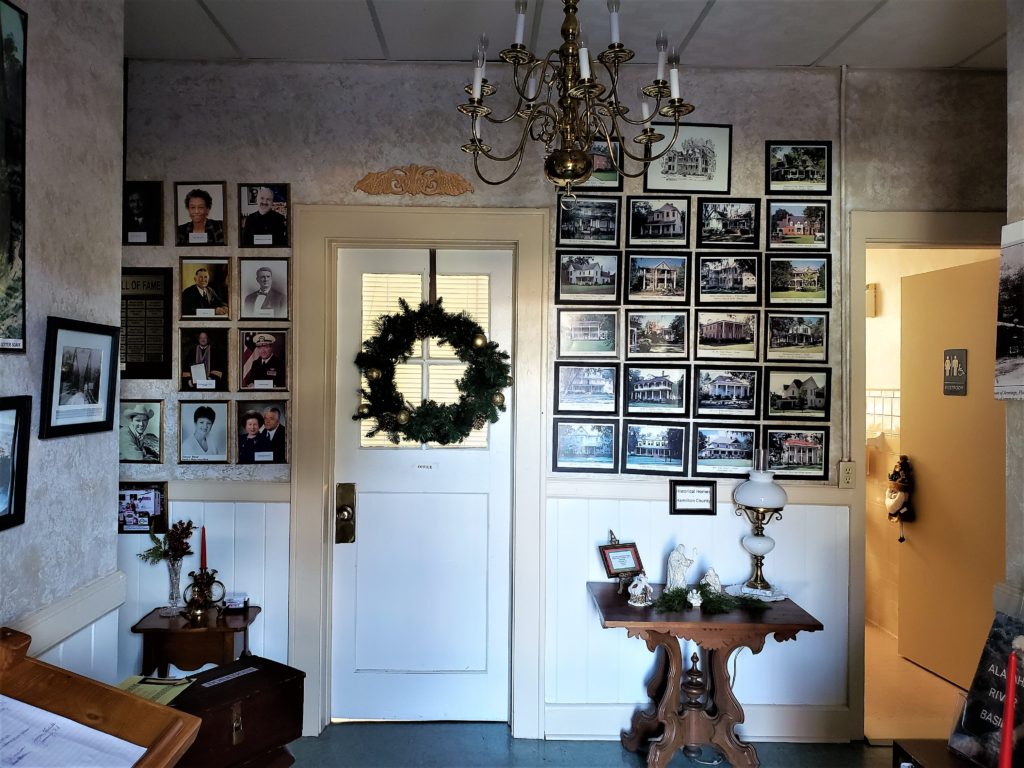
While you are in Jasper, be sure to investigate the Old Jail, built in 1893. The cells look ready to use at a moment’s notice. It is interesting to see the upstairs living quarters—I’m guessing the sheriff didn’t get far from the job! This was Hamilton County’s only jail and was still used until 1984.
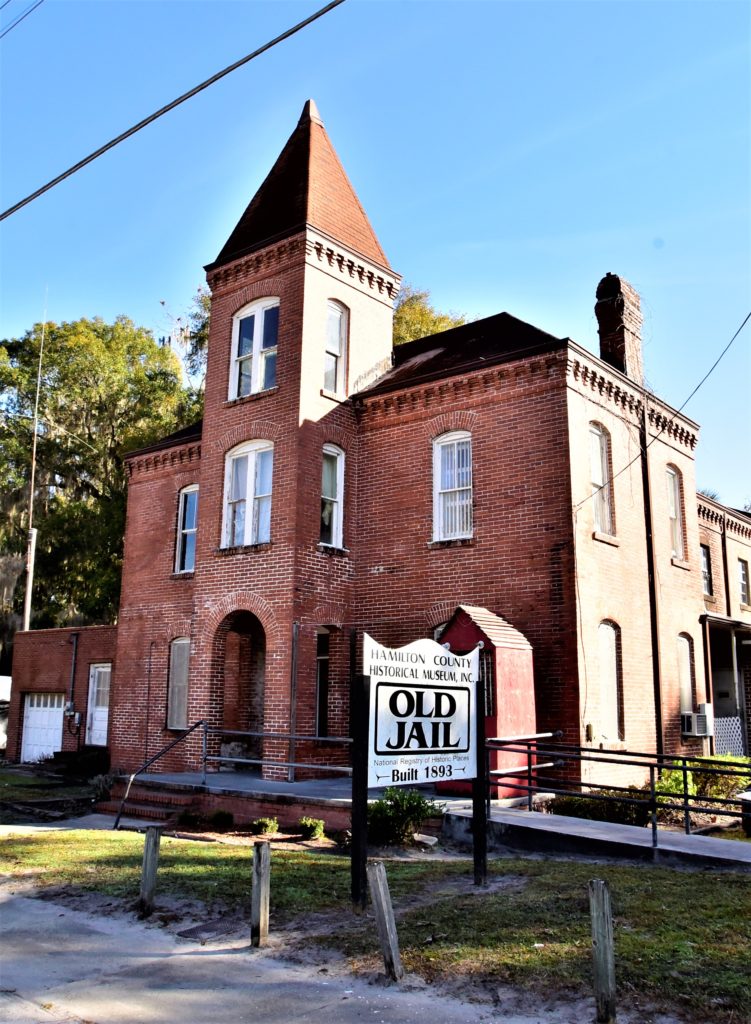
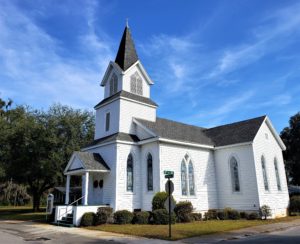
The town of Jasper is still an undiscovered jewel for me. I will have to go back and spend an entire day exploring! Just while I was driving through one morning before a trip on the river, I spotted so many historic buildings! (Yes, I made one of my famous U-turns to capture pictures of this beautiful church, built in 1878.) I need to know more!
19. Where the Wild Things Grow
Hiking the Florida Trail beside the Suwannee River in White Springs I spotted these Indian Pipes. These unique plants go undiscovered by most people because it has no chlorophyll and doesn’t depend on photosynthesis! This ghostly white plant is able to grow in the darkest of forests.
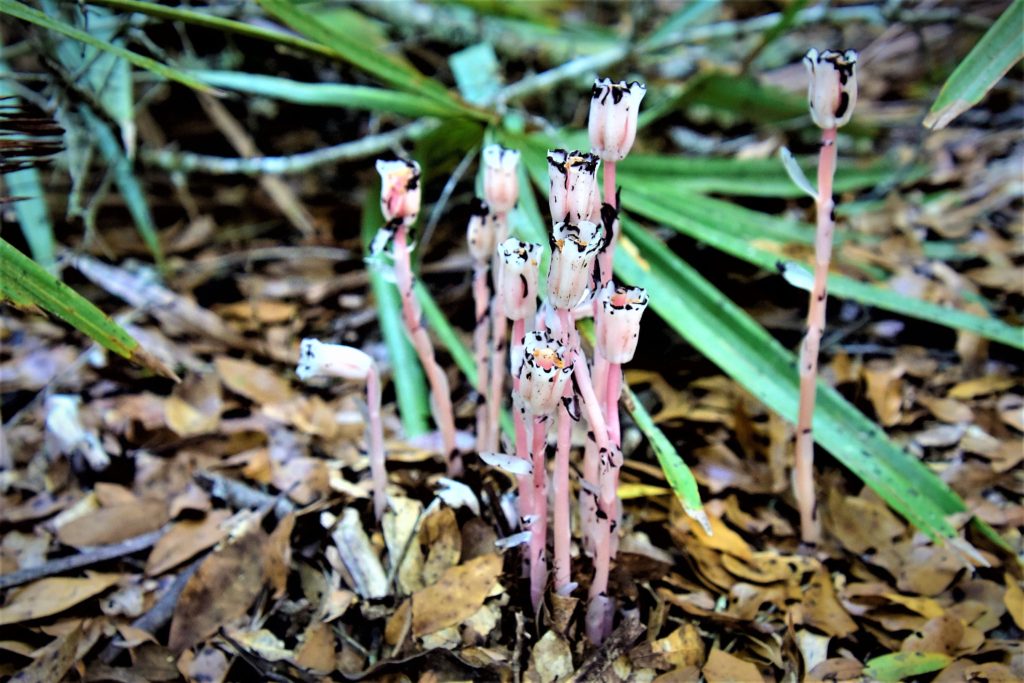
Indian Pipes 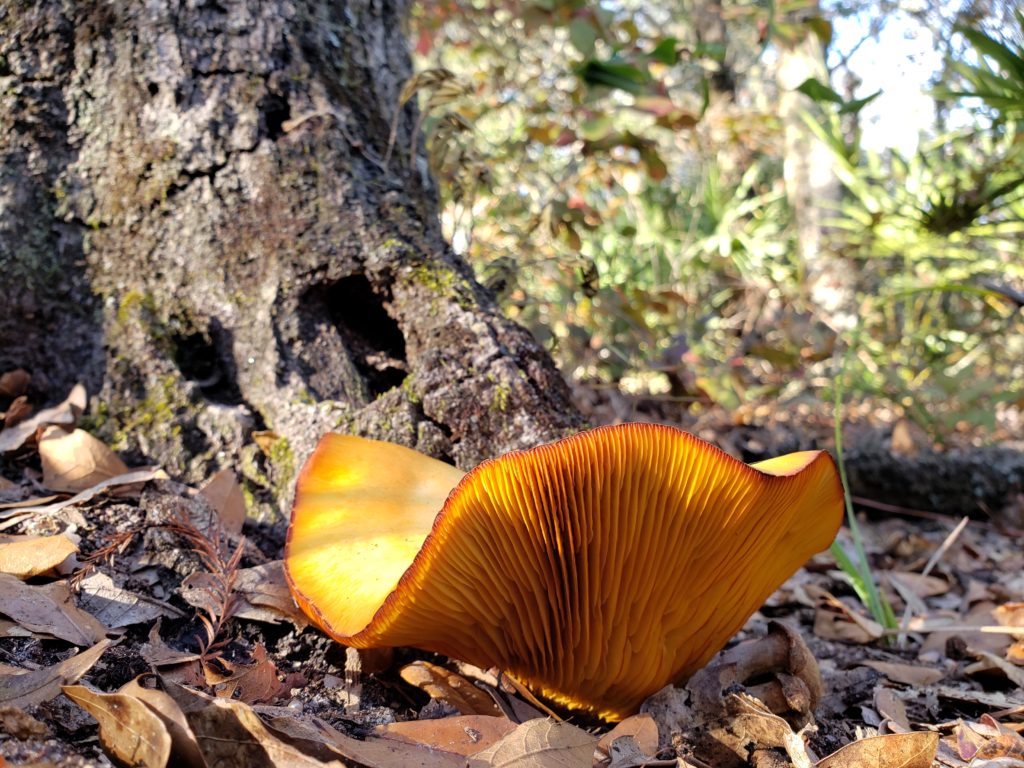
Omphalotus subilludens
20. Festival Celebrations
There are lots of exciting festivals during the year—be sure you take part in some (or all!) At the Stephen Foster Folk Culture Center State Park (whew! Say that three times fast!), you need to check out the events listed on their website. The center is devoted to keeping Old Florida and its traditions alive. Other events are listed on the Hamilton County page of events.
- Wild Azalea Festival – March
- Antique Tractor & Engine Show – March 31-April 2
- Hamilton County Rodeo in Jasper – May
- Florida Folk Festival – May, Memorial Day Weekend – this year will be the 70th!!
- Wild Blackberry Festival
- Fourth of July Celebration
- Old Time Music Weekend – September 9-11
- Come to the River Healing Arts Festival – September
- Jeanie and Stephen Auditions – October
- Quilt Show & Sale – October 21-23
- Big Shoals Pumpkin Fest – October
- Haunted Old Jail – October
- Rural Folklife Days – November
- Dulcimer Retreat – November 11-13
- Festival of Lights – December
- Christmas Parade – December
This breathtaking area of unexplored Florida is less than a day’s drive from Atlanta. Natural North Florida has more to offer than you can imagine. So plan your adventure to the natural parts of Florida, where you can explore springs, rivers, trails, history, and nature. I’ll be looking for you on the trail!
